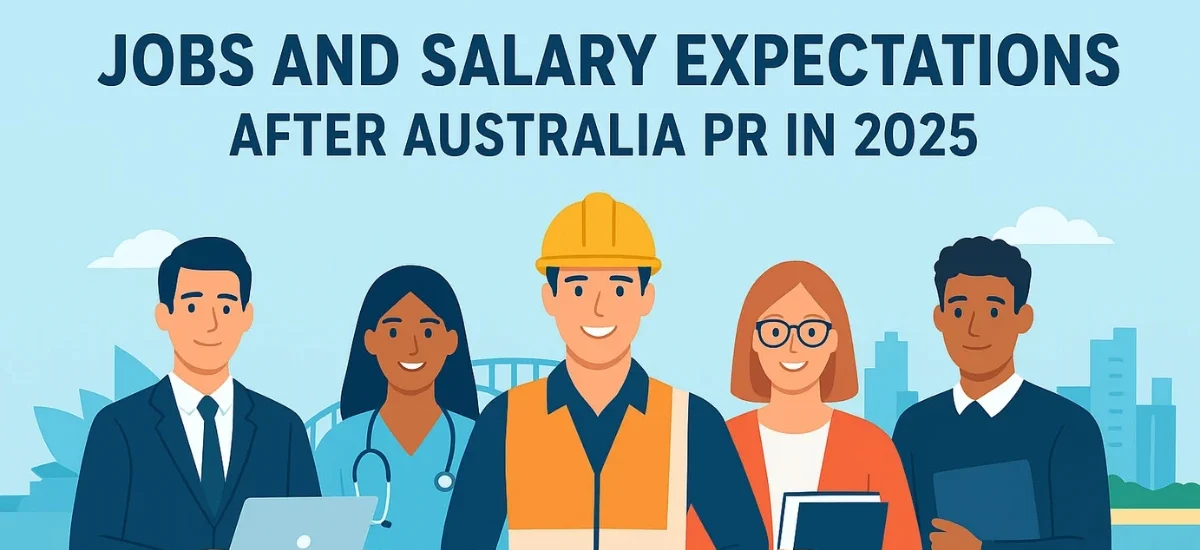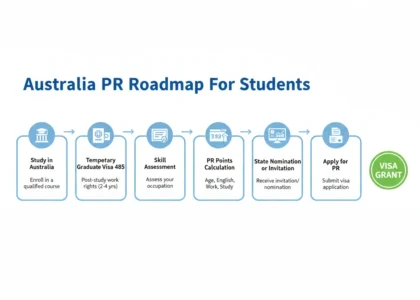Jobs and Salary Expectations After Australia PR in 2025
Australia is a top choice for skilled migrants in 2025. Australia PR lets you live and work in the country permanently and it also gives you access to good jobs, competitive salaries and opportunities to grow your career.
If you are planning to move in australia then it’s important to understand the job market after getting PR. This guide explains the types of jobs available, expected salaries, career growth options and practical tips to make the most of your Australia PR.
1. Top Industries for PR Holders in 2025
Australia’s economy is growing steadily, but certain industries face a skilled labor shortage, making PR holders highly valuable. The top industries include:
Information Technology (IT)
Roles: Software developers, cloud engineers, cybersecurity experts, data analysts.
Demand: Extremely high due to digital transformation across sectors.
Advantage: PR holders can negotiate full-time contracts without visa restrictions.
Healthcare
Roles: Doctors, nurses, aged care workers, physiotherapists, midwives.
Demand: Consistently high because of Australia’s aging population.
Advantage: PR allows access to public health institutions and better pay compared to temporary visa holders.
Engineering & Skilled Trades
Roles: Civil, mechanical, electrical engineers, construction supervisors, welders, electricians.
Demand: Strong demand in infrastructure, energy, and construction projects.
Advantage: Regional areas offer incentives, including higher salaries and relocation support.
Education
Roles: Teachers, early childhood educators, university lecturers.
Demand: High, especially for STEM subjects and regional schools.
Advantage: PR allows easy mobility across public and private institutions.
Finance & Accounting
Roles: Accountants, auditors, financial analysts, tax consultants.
Demand: Stable and growing with Australia’s strong financial sector.
Advantage: PR opens opportunities for promotions and permanent contracts in multinational companies.
2. Salary Expectations After Australia PR in 2025
| Industry / Occupation | Average Salary (AUD) | Notes |
|---|---|---|
| IT Professionals | 80,000 – 150,000* | Highest demand in Sydney, Melbourne, and Canberra. |
| Healthcare Workers | 70,000 – 130,000* | Nurses and aged care workers can earn extra in regional areas. |
| Engineers | 75,000 – 140,000* | Civil, mechanical, and electrical engineers are in high demand. |
| Teachers | 65,000 – 110,000* | STEM and regional teaching roles pay higher. |
| Accountants / Finance Experts | 70,000 – 120,000* | Chartered accountants can earn above 130,000 in senior roles. |
| Skilled Trades | 60,000 – 100,000* | Trades like plumbing, welding, and electrical work get bonuses. |
3. Factors Affecting Salaries
Several key factors influence your earnings after Australia PR:
City of Employment
Sydney and Melbourne offer higher salaries but have higher living costs.
Regional cities like Adelaide, Hobart, or regional Queensland may offer incentives, relocation allowances, and sometimes higher net benefits due to lower costs.
Experience & Qualifications
Australian work experience and local certifications increase salary potential.
PR holders with international experience are often highly sought after in tech, healthcare, and engineering.
Industry Demand
Occupations in short supply often receive higher wages and bonuses.
Example: A senior cybersecurity professional in Sydney can earn up to AUD 160,000.
Skill Upgrades
Additional certifications in cloud computing, project management, or healthcare specialties can significantly boost income.
4. Career Growth Opportunities After PR
Australia PR is not just about living and working; it’s a stepping stone to a thriving career:
Job Flexibility: PR holders can switch jobs freely without employer sponsorship restrictions.
Business Opportunities: Eligible to start your own business and apply for government grants.
Promotions: Permanent employees often have more opportunities for leadership roles.
Retirement & Benefits: Access to superannuation (retirement funds) and healthcare benefits increases financial security.
5. Tips to Maximise Earnings After PR
Target High-Demand Sectors: Focus on IT, healthcare, engineering, and finance for faster growth.
Gain Local Experience: Short-term or volunteer roles can boost credibility with Australian employers.
Consider Regional Employment: Many regional cities offer extra incentives, relocation support, and competitive salaries.
Upgrade Skills Continuously: Certifications, specialized training, and advanced degrees can enhance your earning potential.
Research Salaries Before Negotiation: Use online resources like Job Outlook or SEEK to benchmark your salary.
6. Regional vs Metropolitan Opportunities
Metropolitan Cities: Sydney, Melbourne, Brisbane – high salaries but expensive housing and living costs.
Regional Areas: Adelaide, Hobart, Newcastle, regional Queensland – slightly lower base salaries, but incentives, relocation support, and lower living costs make net benefits attractive.
Regional PR pathways sometimes offer extra points during visa application, encouraging skilled migrants to settle outside major cities.
FAQs
Yes. PR holders often earn higher salaries because they have no work restrictions, and employers don’t need to spend on visa sponsorship. This gives PR holders stronger negotiation power in the job market.
IT professionals, healthcare specialists, engineers, and finance experts are among the highest-paid. Roles in cybersecurity, nursing, and senior engineering positions often exceed AUD 120,000* annually.
While base salaries in regional areas may be slightly lower than in big cities, regional employers often provide relocation incentives, bonuses, and faster career growth due to high demand for skilled workers.
Yes. Employers generally prefer PR holders as they can work without restrictions, stay permanently, and are more likely to commit long-term, making them attractive hires.
You can boost your salary by gaining Australian work experience, upgrading skills with certifications, targeting high-demand sectors, and exploring opportunities in both metropolitan and regional job markets.





